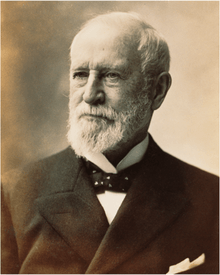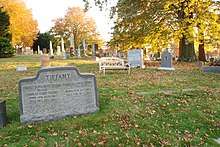Charles Lewis Tiffany
Charles Lewis Tiffany (February 15, 1812 – February 18, 1902) was a leader in the nineteenth century American jewelry trade and founded New York City's Tiffany & Co. in 1837. Known for his jewelry expertise, Tiffany created the country's first retail catalog and introduced the English standard of sterling silver in imported jewelry in 1851.[2]
Charles Lewis Tiffany | |
|---|---|
 | |
| Born | February 15, 1812 Killingly, Connecticut, United States |
| Died | February 18, 1902 (aged 90) Yonkers, New York, United States |
| Resting place | Green-Wood Cemetery |
| Net worth | USD $35 million at the time of his death (approximately 1/616th of US GNP)[1] |
| Spouse(s) | Harriet Olivia Avery Young (1817-1897) |
| Children | 6, including Louis Comfort Tiffany |
Life and career
Tiffany was born on February 15, 1812, in Killingly, Connecticut, the son of Chloe (Draper) and Comfort Tiffany.[3] Tiffany was educated in a district school and in an academy in Plainfield, Connecticut. Starting at the age of 15, he helped manage a small general store started by his father, the owner of a cotton-manufacturing company. He later worked at the office of his father's mill. The Tiffany family descended from the immigrant Squire Humphrey Tiffany (England, 1630-Swansea, Massachusetts, 1685),[4][5] who had lived in the Massachusetts Bay Colony in 1660.[6]
In 1837, with $1,000 borrowed from his father, Tiffany and a school friend, John B. Young, set up a small stationery and gift shop in New York City. Their first three days in business brought them only $4.38 in total sales, but two years later they were still in business, selling glassware, porcelain, cutlery, clocks and jewelry.[6]
The store expanded in 1841 and changed its name to Tiffany, Young and Ellis. It established a reputation for selling only the finest goods and specialized in Bohemian glass and porcelain. It also began manufacturing its own jewelry. In the early 1850s, the company was reorganized under the name Tiffany and Company and opened branches in Paris (1850) and London (1868). The store also relocated uptown to a Fifth Avenue location in that decade.[6]

Tiffany was terribly embarrassed in an 1872 diamond and gemstone hoax perpetrated by Philip Arnold that cost investors more than half a million dollars.
In cooperation with Thomas Edison, Tiffany created footlights and other methods of theater lighting.[7] As a result of this, Broadway and other shows became more popular during that time.
The firm acquired and sold some of the French Crown Jewels in 1887, firmly establishing its reputation.[8]
Charles Tiffany died at his home in Manhattan, New York, on February 18, 1902, at age 90.[9] At the time of his death his company was capitalized at more than $2 million and acknowledged as the most prominent jewelry company in North America.[6]
Personal life
_pg155_THE_CHARLES_L._TIFFANY_RESIDENCE._MADISON_AVENUE%2C_NORTHWEST_CORNER_OF_SEVENTY-SECOND_STREET.jpg)

On November 30, 1839, Tiffany married John B. Young's sister, Harriet Olivia Avery Young (1817–1897), with whom he had six children: Charles Lewis Tiffany Jr. (1842-1847), Annie Olivia Tiffany Mitchell (1844-1937; grandmother of Hiram Bingham IV through her daughter Alfreda Mitchell and she, at the same time, is the first wife of Hiram Bingham III, one of the first explorers to Machu Picchu, Peru),[10][11] Louis Comfort Tiffany (1848-1933), Louise Harriet Tiffany (1856-1937), Henry Charles Tiffany (1858-1859) and Burnett Young Tiffany (1860-1945).
In addition to his business, Tiffany was a patron of the Metropolitan Museum of Art and one of the founders of the New York Society of Fine Arts.[6]
Honors
Tiffany was made a chevalier of the Legion of Honour in 1878.[12]
References
Notes
- Klepper, Michael; Gunther, Michael (1996), The Wealthy 100: From Benjamin Franklin to Bill Gates—A Ranking of the Richest Americans, Past and Present, Secaucus, New Jersey: Carol Publishing Group, p. xii, ISBN 978-0-8065-1800-8, OCLC 33818143
- "Tiffany & Co. For The Press | About Tiffany & Co. | A Legacy of Sterling Silver | United States". press.tiffany.com. Retrieved August 14, 2018.
- http://www.nycgovparks.org/parks/tiffanyplayground/history
- Heydt, G. F. (1893). Charles L. Tiffany and the House of Tiffany & Co. Tiffany & Company.
- Roth, David M., editor, and Grenier, Judith Arnold, associate editor, "Connecticut History and Culture: An Historical overview and Resource Guide for Teachers", published by the Connecticut Historical Commission, 1985, page 155
- "History of Tiffany Lamps & Lampshades". www.tiffanyshades.com. Retrieved April 9, 2018.
- Tiffany & Co. | Biographies | Charles Lewis Tiffany |
- "Charles L. Tiffany Dead". New-York Tribune. February 19, 1902. Retrieved November 9, 2019.
- "Hiram Bingham; Diplomat, 84". The New York Times. January 17, 1988. Retrieved June 9, 2013.
- "Illustrations from the Tiffany Fortune: Founder of Tiffany & Co., Charles Tiffany with his granddaughter Alfreda Mitchell, 1877". tiffanyfortne.com. October 12, 2007. Retrieved June 9, 2013.
- Chisholm, Hugh, ed. (1911). . Encyclopædia Britannica (11th ed.). Cambridge University Press.